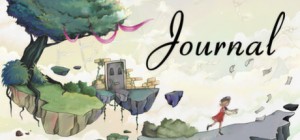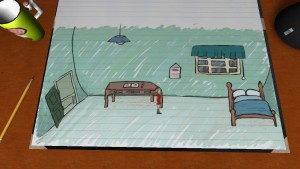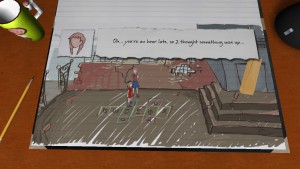written by David Steffen
The most compelling stories draw the reader in, leaving the body in a trance, as you immerse completely into a character’s mind. This is the biggest advantage that books hold over movies. A movie can show us a story, but even the best movies maintain a certain distance–you see the story through the eye of the camera, not the eyes of the character.
Movies have their own advantages, particularly for speculative fiction. A complex fantasy city can be shown in a matter of seconds, which might take chapters of drawn-out prose to describe in detail. Subtle facial expressions are presented without interpretation so that the watcher can interpret in any way they wish. The cinematic view can vary so that battlefields or other large-scale scene can be seen from far above without a character to carry us there.
Emulating film in writing is an easy trap to fall into, especially for beginning writers. Cinematic writing is characterized by overly long descriptions of complex settings and impartial narration as though attempting to show what a camera would see. But to write fiction in this manner is to sell yourself short. No one can portray a story in a film-like manner as well as film itself can. It’s like trying to write a story with French words using English grammar, it just doesn’t work. I’m not saying you can’t tell about the same story, the same characters, the same events as you could show in the movie. But you need to use different methods to reach its full potential.
I like to imagine prose as a narrative lens that allows you to see through the eyes of the character. And not just see, but to experience what they experience. Using this method, every description, every beat, every line of narration is an opportunity to characterize your point of view character.
To illustrate what I mean, I’ll describe a scene, and show how the narrative lens can be used to good effect. Imagine a Medieval time period, with an opening scene at a grand ball in a palace. All the royalty are decked out in garish attire, women with hairdos three feet tall, elaborate frilly dresses with padded rumps. The men’s clothes are nearly as elaborate as the women’s. The palace is richly decorated with marble pillars, satin curtains, and a great dome that rises high above their heads.
In a film, all of this would be given to the viewer in just a few images, and the scene would be shown in an identical way no matter who the point-of-view character is. After a few seconds it could get right on to the characters and the story. That’s the greatest strength of film, the ability to convey a complex setting in just a few moments.
How would it be described in writing, using the narrative lens? Well, that all depends who the character is. No character will notice every detail of the setting or the people around them. They will notice only a subset, but the choice of what subset serves as characterization. I’ll describe what each character sees and you can guess what role they might play.
Sarah barely describes the hall at all, mentioning a marble pillar only in passing as she’s watching someone move through the crowd and disappear behind it. She notes the scent of her wine as she scans the crowd. She notes women wearing the latest fashions, and those wearing clothes laughably out-of-date. The servers are invisible to her, though she may take a glass of wine from time to time, it will come to her hand with no mention of the server’s appearance. ÂWhen she speaks to people, she not only hears what they say, but the political undercurrents, a flip of the eyelashes that mark a veiled insult. She focuses most of her attention on minute behaviors of others and herself, and understands the significance behind each of them. A street urchin bumps into her, and she only looks at him for a moment, notes his smell, and then he disappears from her notice again. ÂShe ignores him after that, absorbing herself in examining her dress for stains the urchin might have left.
Louis can’t stop staring up at the ceiling, which is so tall he’s surprised there aren’t any clouds hanging under the roof. He smells hundreds of kinds of food, a few familiar, most of them entirely strange. The marble pillars fascinate him, the swirling patterns through the stone. He stares openly at a dress’s rump padding and can’t help but laugh. He looks servers in the eye. He sees a man with a grandly trimmed mustache and wonders if his dad has ever had a mustache like that. The shininess of polished shoes fascinates him.
Godric enters the hall. He notes the hall, but only to point out that the furnishings aren’t as nice as the palace he was at last week. He notes the quality and size of gemstones in the ladies’ jewelry. He notes the number of windows and their height from the floor. Unlike the duchess, he notices the pillars. Unlike the urchin, he doesn’t care about the swirling patterns in the stone, but considers the spacing and thickness, the way the shadows would pool when lit by just a few torches. He notes the hardness of a man’s eyes and the confidence of his stance. He notices servers’ entrances, the quality of the candlesticks, and the number of armed guards.
The woman is a duchess, the boy a street urchin, and the man an accomplished thief. Notice how the details of what each person described served to hint at their roles before any description of their clothing or their occupation was given. Note also, that if you exchanged some of the descriptions in each section, it would seem out of place. If the thief notes that the ruffles on a woman’s dress are an outdated style, then that would seem odd. Perhaps he’s a strange thief who is actually interested in ladies’ fashion, and there’s nothing wrong with that, but to keep the point of view tight, this has to be a conscious choice by the writer. It shouldn’t be included merely because the writer wants to show off his knowledge about fashions of that era, but because the character himself would notice it.
If that’s too extreme of an example, with too archetypal characters, consider a modern scene. A husband is doing the dishes when he’s confronted by his wife. She accuses him of cheating on her.
From her point of view:
Susan frowned. “Tell me the truth.”
Tom pulled a handful of silverware out of the sink. Drying them one by one, he stacked them in the drawer. “The truth is… complicated.”
Notice the lengthy description of his silverware drying and putting away. She’s noting his every move, because every moment he doesn’t respond only implicates him further. Every word in those sentences, which translate to some delay in the reader’s mind, is another line of evidence to her, so she’s watching every tiny detail.
From his point of view:
How could she know? He’d been so careful, only calling from pay phones, bringing an extra shirt to the office in case of lipstick stains, going to the gym after work to give him an excuse to shower. She couldn’t know. She couldn’t, and that was that.
Notice he doesn’t mention the silverware at all. He’s at the moment of the accusation, and his mind is racing, trying to mentally assemble what evidence she might have against him. His hands are moving of their own volition. He’s not aware of them, so he can’t mention them.
Also, the space of the description is of utmost importance. Long passages give the sense to the reader of a passage of time, regardless if that was the writer’s intent. If a scene is described in excruciating detail, then not only should the character himself be interested in that detail, he should also have the time to describe what he’s seeing.
Consider a scene where our hero clashes swords with enemy fighters. He takes down an enemy warrior and happens to catch a glimpse of Gorlack, the enemy commander. Gorlack is eight feet tall, with a ring through his nose, and six arms. The battlefield is a spray of blood from his ceaseless slaughter. His armor is decorated with human skulls, many of them marked where they’ve been gnawed by teeth. In the eyes of each skull, a gemstone. In each hand, a deadly weapon. Gorlack arches his back and gives a bellow of rage before returning to the carnage.
If they’re really on a crowded battlefield full of enemy soldiers, then this passage suggests that the hero has been standing there gawking for quite some time, probably half a minute or more, and he’s lucky he hasn’t been stabbed through the back by now. To keep the narrative lens firmly in place, this description would have to be shortened significantly, and perhaps split across several paragraphs as he steals glances at Gorlack while he fights enemy soldiers.
If you’re struggling with fitting characterization in a story, or you’re afraid the narration is too dry, give the narrative lens a try. A writer’s toolbox always has room for one more technique.
 Journal is a dialog based narrative story game by Locked Door Puzzle released in 2014. The story follows a young girl who has discovered that the pages in her journal have gone blank and she sets out to try to find what happened to them. The game plays out as she talks to different characters in life, and asks them about the journal, and different interpersonal conflicts arise–her mother, her father, her classmates, teacher, priest. The game is a little bit of exploration as she walks around a larger area and finds new people to talk to with each level of the game, but mostly the game comes down to dialog choices. When her best friend accuses her of not being a good friend, does she apologize or deny it? When her teacher asks her if she cheated on a test does she own up to it or cover it up? Making the “right” choice doesn’t always produce a happy outcome–as with many things in life. As the game goes on she’s always kind of feeling her way around things that she doesn’t really want to remember.
Journal is a dialog based narrative story game by Locked Door Puzzle released in 2014. The story follows a young girl who has discovered that the pages in her journal have gone blank and she sets out to try to find what happened to them. The game plays out as she talks to different characters in life, and asks them about the journal, and different interpersonal conflicts arise–her mother, her father, her classmates, teacher, priest. The game is a little bit of exploration as she walks around a larger area and finds new people to talk to with each level of the game, but mostly the game comes down to dialog choices. When her best friend accuses her of not being a good friend, does she apologize or deny it? When her teacher asks her if she cheated on a test does she own up to it or cover it up? Making the “right” choice doesn’t always produce a happy outcome–as with many things in life. As the game goes on she’s always kind of feeling her way around things that she doesn’t really want to remember. I thought the idea for this game was interesting. I liked how it didn’t go the straightforward After School Special route where if you do the right thing then everything will turn out happy for you. I thought the art was nice enough, and the voice acting good. I picked up on the sense that the narrative was kind of feeling around the empty spaces where other events in her life would be revealed to be, which I thought was an interesting technique.
I thought the idea for this game was interesting. I liked how it didn’t go the straightforward After School Special route where if you do the right thing then everything will turn out happy for you. I thought the art was nice enough, and the voice acting good. I picked up on the sense that the narrative was kind of feeling around the empty spaces where other events in her life would be revealed to be, which I thought was an interesting technique. Visuals
Visuals